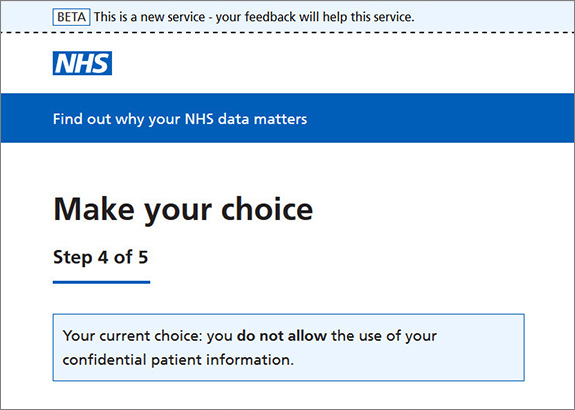A serious error affecting 150,000 NHS patients has been reported in the media in recent days, after it was uncovered last week. We understand the error affects patients who set an opt-out between March 2015 and June 2018 and whose GP practices use TPP’s SystmOne software – their opt-out codes were not sent to NHS Digital until last week.
As a consequence of this error, from April 2016 until 26 June this year, those patients’ confidential, identifiable data was sold to a range of organisations, including private companies. This will obviously be of concern to a great many people.
Both TPP and NHS Digital are taking remedial action; the coding error has been corrected to ensure opt-outs will be uploaded properly from now on, affected GP practices were written to on Monday 2 July, and the individual patients affected should be written to by the end of the month.
Until then, based on current information, this is what you can do:
If you have recently received a letter from NHS Digital about the conversion of your Type-2 opt-out to the National Data Opt-out then you weren’t affected by this incident. (These letters were sent out during June.)
If however you haven’t received a letter, and you are over 16, and you remember opting out any time from March 2015 onwards, then either:
- a) you are affected by the TPP incident, or
- b) separately, your opt-out was never applied to your GP record.
Anyone over the age of 13 should be able to check their current opt-out status by using NHS Digital’s new online National Data Opt-out process:

If the light blue status box does not appear when you check and you do not wish your confidential, identifiable medical information to be used for any purposes beyond your own direct care, then you need to set the option on this screen to “No”.
This new online process only works, however, for individuals over 13 years old – and not for families with children or adult dependants. medConfidential’s (now improved!) GP opt-out form continues to work, as it has done since late 2013. It also lets you prevent confidential, identifiable information leaving your GP record, which the National Data Opt-out does not cover.
But – given this incident, and every previous breach of public trust – why can’t every patient see their data, so they can know what has happened?
Everyone agrees how bad the situation created by TPP’s error, with consequences for patients from their data being used against their wishes, really is:
Professor Helen Stokes-Lampard, Chair of the Royal College of GPs, said:
Patient data held by the National Health Service should only ever be used morally, safely and responsibly, and we must all work together to ensure mistakes of this nature are never repeated. We need to be able to reassure patients that their wishes concerning their data are being respected.
Understanding Patient Data said in response (their emphasis):
This incident highlights the critical need for transparency – to ensure that it is clear where data is going and how choices are honoured. It also demonstrates that a trustworthy system must not just say the right things but also do the right things in practice as well: if opt-outs are claimed to be honoured, they absolutely must be. If these standards are not upheld, there has be clear accountability in the system, with sanctions if necessary to demonstrate that these issues are taken seriously, or public confidence will again suffer.
Dr Natalie Banner, who now leads the ‘Understanding Patient Data’ project, tweeted:
Astonishing and appalling failure to uphold patient objections: but what sanctions to ensure providers uphold the standards we expect of them? New opt-out, which is patient-registered rather than GP-registered, *should* be less liable to such errors though.
Mr Harry Evans, from the Kings Fund policy team, said:
We are all agreed on the importance of the public not being surprised by how NHS uses data, so this is just remarkable.
These are fine words, but when will they speak out about the people NHS Digital disregarded in its new ‘digital’ process – a process that Ministers signed off – which separates processing for parents and children? (Not every American policy approach should be replicated in the NHS…)
In a recent explanation for OurNHS, we showed the ‘proxy’ form itself says:
…if your family has children under the age of 13, or if you look after a dependent older relative, then things are even more complicated. Rather than giving a simple instruction to your doctor, those who would prefer their children’s data wasn’t sold to third parties for unknown purposes, will be required to send to NHS Digital, by post, four pieces of ID documentation along with a seven-page form. So much for Jeremy Hunt’s much-vaunted commitment to a ‘paperless’ NHS.
Given the significant effect this will have on people far wider than the 150,000 currently affected, you might want to ask (a) Understanding Patient Data, or (b) your MP, what they are doing to ensure the broken process for families making a decision together is fixed.
